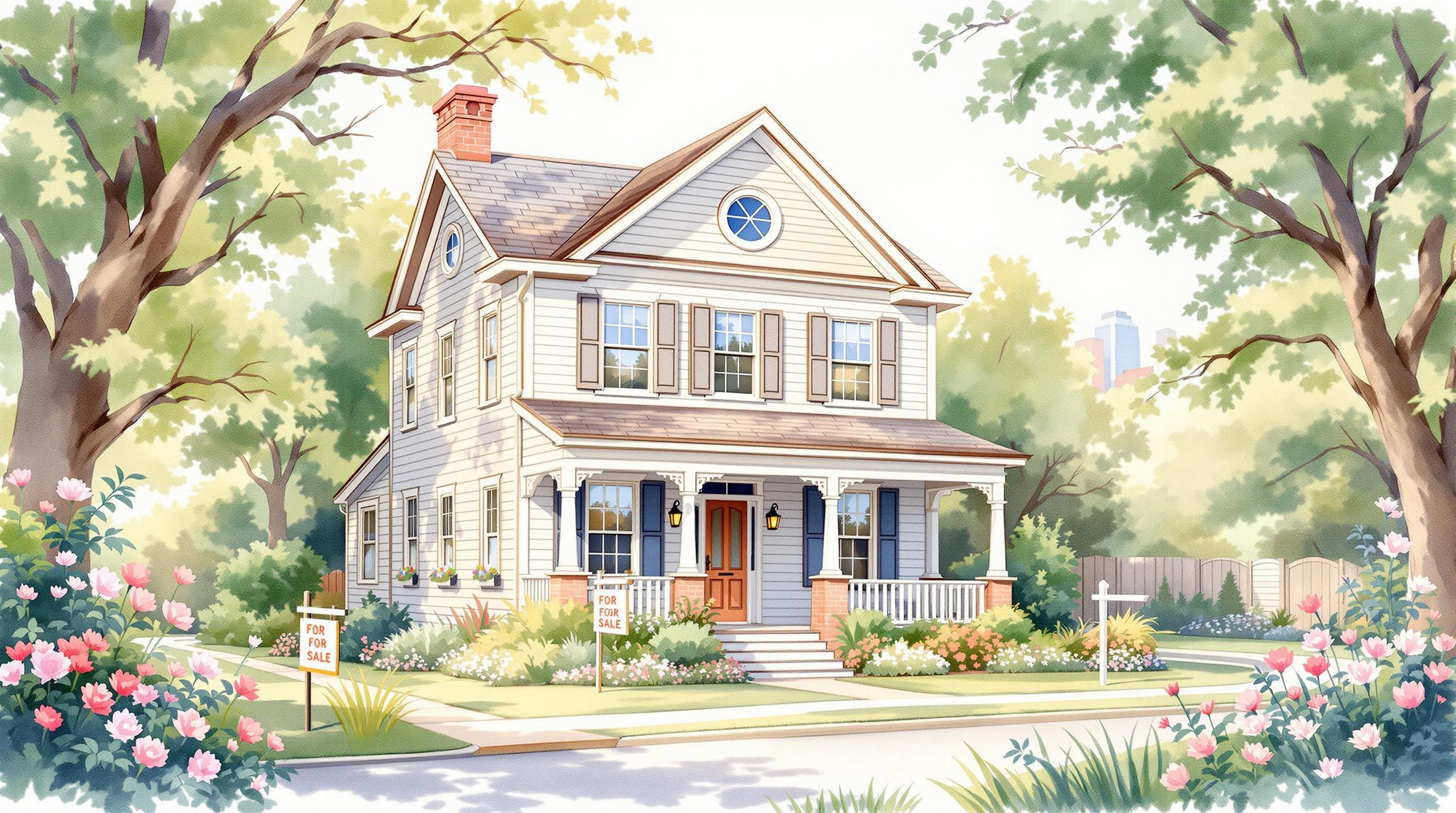- Median Rate: 2.14%, higher than the national median of 1.1%.
- Average Annual Bill: $3,911, influenced by county, municipal, and school district taxes.
- Major Contributor: School taxes make up 60-70% of total bills.
- Assessment System: Based on a 2015 valuation, reassessed every 8 years (next in 2027).
- Range: Tax bills vary from $2,996 to $5,245 annually, depending on location.
Quick Example
For a $200,000 home:
- County Tax: $2,960
- School Tax: $2,360-$4,720
- Municipal Tax: $800-$1,600
Ways to Save
- Apply for the PA Tax Rebate Program (up to $975).
- File an assessment appeal (deadline: August 1).
- Explore exemptions like Homestead or veteran benefits.
Property taxes in Lancaster significantly affect housing costs for both buyers and renters. Understanding the system and available relief options can help you manage your tax burden effectively.
Property Tax Basics in Lancaster
Millage Rates Explained
In Lancaster, property taxes are calculated using millage rates, which represent $1 for every $1,000 of a property's assessed value. Your tax bill combines rates from three sources: county, municipal, and school district taxes. Notably, schools typically account for 60-70% of the total amount.
| Taxing Authority | Rate Type | 2024 Rate |
|---|---|---|
| Lancaster City | Mills | 12.64 |
| Lancaster County | Effective Rate | 1.48% |
| School District | Mills | Varies by district |
Property Values: Assessed vs. Market
Lancaster County uses a system that separates a property's market value from its assessed value. While the market value reflects what a property might sell for, the assessed value - used to calculate taxes - is typically lower [3].
Lancaster County Assessment Office Functions

The Lancaster County Assessment Office oversees property tax administration. Here's a breakdown of their main responsibilities:
1. Reassessment Process
Every eight years, the office conducts a property reassessment using computer-assisted mass appraisal systems [3]. This involves reviewing recent sales data, property upgrades, and market trends to ensure fair market values.
2. Record Maintenance
The office manages detailed property records and oversees various tax relief programs, such as:
- Homestead Exemption
- Rebates for seniors or disabled individuals
- Agricultural discounts
- Veterans' benefits [2]
3. Appeals Management
Property owners can challenge their assessments through a formal appeal. Appeals must be submitted by August 1st for the following tax year [2]. The Board of Assessment Appeals meets monthly to review and decide on cases [2].
These processes directly influence how property taxes are calculated - a topic we'll explore further in the next section.
PA Homestead Rebate - Lancaster County Property Tax Relief Guide
Property Tax Calculation Methods
Understanding how property taxes are calculated in Lancaster County means breaking it down into its main components. Let’s look at the details and how they affect homeowners.
Tax Calculation Steps
Lancaster County uses a straightforward formula based on a 100% market value assessment system [1]. Here's an example for a home valued at $200,000 with current rates:
| Tax Component | Millage Rate | Annual Tax on $200,000 Home |
|---|---|---|
| County | 1.48% | $2,960 |
| Municipal | Varies | $800-$1,600 |
| School District | 1.18%-2.36% | $2,360-$4,720 |
To figure out your tax bill, divide the total millage by 1,000 (e.g., 23.6 mills equals a rate of 0.0236). While this system provides predictable numbers, tax amounts can differ significantly between neighborhoods.
School District Tax Rate Comparison
School district taxes take up the largest share of property taxes in Lancaster County. Rates vary widely depending on the district:
| School District | Millage Rate | Annual Tax on $200,000 Home |
|---|---|---|
| Lancaster City | 23.6 | $4,720 |
| Pequea Valley | 15.8 | $3,160 |
These differences can have a big impact on housing costs, especially for families who consider school quality a top priority.
Combined Tax Impact
Property taxes in Lancaster County combine rates from the county, municipal, and school district levels. The median property tax rate is 2.14%, with most homeowners paying around $3,911 annually [4].
The county uses 2015 as the base year for property assessments, with the next reassessment planned for 2027 [6]. This approach helps maintain consistency in valuations while allowing updates over time.
sbb-itb-7fa5722
Property Taxes and Housing Costs
Property taxes play a major role in housing affordability, impacting both buyers and renters in Lancaster. Here's how they affect costs and development decisions:
Costs for Buyers and Renters
For homeowners, property taxes add about $325 per month to the cost of a median-priced home. Renters aren’t off the hook either - landlords pass along these costs, with renters paying an estimated $246 per month for a $200,000 property [1]. These added expenses ripple across the housing market, shaping everything from rental pricing to construction priorities.
| Housing Type | Monthly Tax Impact | Annual Tax Cost |
|---|---|---|
| Median Home ($263,600) | $325 | $3,901 |
| Rental Property ($200,000) | $246 | $2,960 |
Effects on Housing Development
Lancaster’s property tax rates heavily influence decisions about new housing projects. For example, Lancaster City's rate of 23.6 mills forces developers to weigh tax costs when planning. To stay profitable, many builders focus on higher-end properties, which makes it harder to prioritize affordable housing in areas with steep taxes.
This tax-driven approach has slowed the construction of more affordable options, especially in neighborhoods with higher rates.
Tax Costs for Average Homes
Property tax bills vary widely depending on the ZIP code, directly affecting which neighborhoods are accessible to different income levels. For instance:
| Location | Median Annual Tax Bill |
|---|---|
| Zip 17551 | $7,004 |
| Zip 17601 | $4,274 |
| Zip 17602 | $3,708 |
| Zip 17603 | $3,725 |
The disparity is stark. While homeowners in the 25th income percentile pay $2,996 annually, those in the 75th percentile face bills of $5,245 [4]. These differences are critical for anyone planning long-term housing or financial strategies in the area.
Ways to Reduce Property Taxes
Homeowners in Lancaster facing steep property taxes - ranging from $2,996 to $5,245 annually [4] - have options to ease the burden. Let’s explore three practical approaches: state rebates, assessment appeals, and professional assistance.
PA Tax Rebate Program Guide

Pennsylvania’s Property Tax/Rent Rebate Program offers financial relief of up to $975 for qualifying residents. Eligible applicants include those aged 65 or older, widows aged 50 or older, and adults with disabilities [2]. To qualify, homeowners must have an annual income of $35,000 or less. In 2021, this program provided $213 million in rebates to more than 440,000 residents across the state [2]. Applications are accepted yearly, with deadlines usually set in June.
How to Appeal Your Assessment
Think your property is overassessed? Lancaster County allows homeowners to appeal their property assessments, with a critical deadline of August 1st for the next tax year. To strengthen your case, gather the following:
| Required Documentation |
|---|
| A professional property evaluation from the past 6 months |
| Recent sales data for 3-5 comparable properties in your area |
| Photos, repair estimates, or inspection reports |
| Your current property record card with all details |
The Board of Assessment Appeals meets monthly (except in December) on the second Wednesday to review appeals [5]. Before filing a formal appeal, try requesting an informal review - this step often resolves disputes without needing a hearing.
Central PA Realty Tax Services

Central PA Realty assists homeowners in challenging inaccurate assessments and helps buyers locate properties with lower tax obligations.
Other tax relief programs worth considering include:
- Tax deferral programs for seniors
- LERTA tax abatements for property improvements
- Historic preservation tax credits for approved renovations
Summary
Throughout this guide, we've broken down how Lancaster's property taxes directly affect housing affordability in three main ways. With a combined county rate of 1.48%, plus municipal and school district taxes, Lancaster ranks among Pennsylvania's highest property tax areas. In Lancaster City alone, school taxes make up a hefty 60-70% of total bills [1].
The 1.48% average rate means an extra $325 per month for the median home, making property taxes a key factor for both current and future homeowners [1]. Payments are due by October 31, but homeowners can take advantage of early payment discounts or installment plans.
Despite the high costs, there are ways to manage them. The Lancaster County Assessment Office reviews appeals and exemptions monthly, with requests for appeals due by August 1 for the next tax year [2]. Eligible homeowners can lower their tax bills through rebate programs (up to $975), assessment appeals, or exemptions like the Homestead reduction (a $25,000 value cut) and veteran benefits.
For tailored advice on handling assessment appeals or making tax-savvy home purchases, reach out to Central PA Realty's local specialists.
FAQs
What is the property tax rate in Lancaster County PA?
In Lancaster County, the average property tax rate is 1.48%, though rates can vary widely across different municipalities and school districts. The median rate is 2.14%, which is above the national average but still below Pennsylvania's state median [4]. These rates play a big role in determining homeownership costs, especially in areas with higher taxes that may require more careful financial planning.
In Lancaster City, property tax rates range between 14 and 36 mills (1 mill equals $1 in tax per $1,000 of assessed value). On average, homeowners in Lancaster pay an annual property tax bill of $3,911 [4]. This total includes:
- County operating millage (101.0 mills)
- School district millage (236.0 mills)
- Municipal millage rates [7]
If you’re looking to challenge your property tax assessment, check out the 'How to Appeal Your Assessment' section for guidance.



